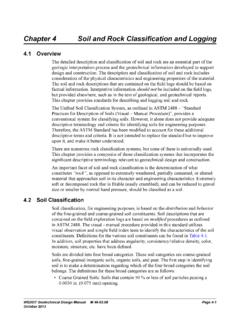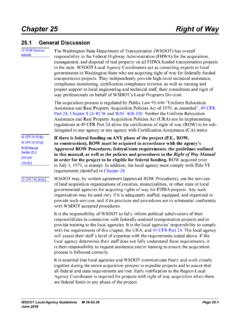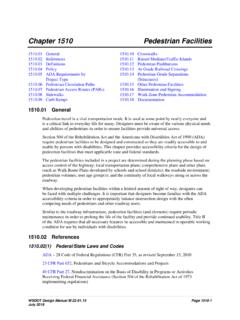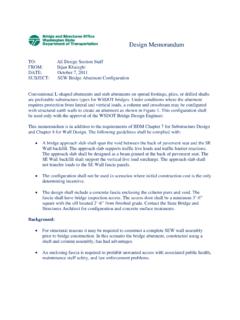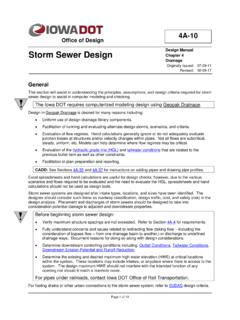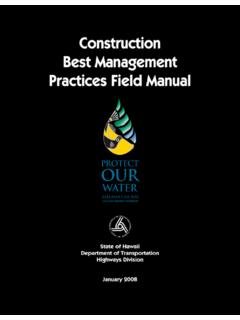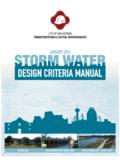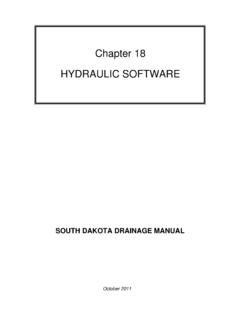Transcription of Chapter 6 Storm Drains - Washington State Department of ...
1 Chapter 6 Storm Drains 6-1 Introduction A Storm drain ( Storm sewer) is a network of pipes that conveys surface drainage from a surface inlet or through a manhole, to an outfall. Storm Drains are defined as closed pipe networks connecting two or more inlets, see Figure Storm drain networks typically consist of lateral(s) that discharge into a trunk line. The trunk line then receives the discharge and conveys it to an outfall. Storm Drain Structure Figure While configurations like the one shown in Figure are typical, there are also other configurations that do not meet the Storm drain definition as shown in Figure In cases where there is only one inlet and no more than two pipes, this should be classified as a culvert on the plan sheets and designed as follows: 1. Storm drain that does not require pressure testing. 2. Lateral that does not require pressure testing. WSDOT Hydraulics Manual M Page 6-1. June 2010. Storm Drains Chapter 6. 3. Storm drain that does require pressure testing.
2 4. Storm drain that does not require pressure testing. Storm Drain Configurations Figure All Storm drain designs will be based on an engineering analysis which takes into consideration runoff rates, pipe flow capacity, hydraulic grade line, soil characteristics, pipe strength, potential construction problems, and potential runoff treatment issues. The majority of time spent on a Storm drain design is calculating runoff from an area and designing a pipe to carry the flow. A Storm drain design may be performed by hand calculations or by one of several available computer programs and spreadsheets. In addition to Storm drain design guidance, this Chapter also contains information on drywells (Section 6-7), pipe materials used for Storm Drains (Section 6-8), and designing for subsurface drainage (Section 6-9). 6-2 Design Criteria Along with determining the required pipe sizes for flow conveyance and the hydraulic grade line, Storm drain system design should consider the following guidelines: 1.
3 Soil Conditions Soil with adequate bearing capacity must be present to interact with the pipes and support the load imparted by them. Surface and subsurface drainage must be provided to assure stable soil conditions. Page 6-2 WSDOT Hydraulics Manual M June 2010. Chapter 6 Storm Drains Soil resistivity and pH must also be known so the proper pipe material can be specified. See Section 8-5 for further guidance. 2. Inlet Spacing and Capacity Design guidelines for inlet spacing and capacity are detailed in Chapter 5, Drainage of Highway Pavements. For minimum clearance between culverts and utilities, designers should consult the Region Utilities Office for guidance. 3. Junction Spacing Junctions (catch basins, grate inlets and manholes). should be placed at all breaks in grade and horizontal alignment. Pipe runs between junctions should not exceed 300 feet (100 meters) for pipes smaller than 48 inches (1,200 millimeters) in diameter and 500 feet (150 meters) for pipes 48 inches (1,200 millimeters) or larger in diameter.
4 When grades are flat, pipes are small or there could be debris issues;. designers should consider reducing the spacing. Region Maintenance should be consulted for final approval on maximum spacing. 4. Future Expansion If it is anticipated that a Storm drain system may be expanded in the future, provision for the expansion shall be incorporated into the current design. Additionally, prior to expanding an existing system, the existing system should be inspected for structural integrity and hydraulic capacity. 5. Velocity The design velocity for Storm Drains should be between 3 to 10 feet per second. This velocity is calculated using Manning's Equation (6-1), under full flow condition even if the pipe is only flowing partially full with the design Storm . The minimum slope required to achieve these velocities is summarized in the Figure 6-2. Pipe Diameter (inches) Minimum Slope (ft/ft). n= fps 3 fps 12 15 18 24 Minimum Storm Drain Slopes Figure 6-2.
5 When flows drop below 3 feet per second ( meter per second), pipes can clog due to siltation. Flows can be designed to as low as feet per second with justification in the hydraulic report however, lower velocities require prior approval. As the flow approaches (and exceeds) 10 feet per second, higher energy losses are produced in the Storm drain system that WSDOT Hydraulics Manual M Page 6-3. June 2010. Storm Drains Chapter 6. can cause abrasion in the pipes. For velocities approaching or exceeding 10 feet per second, designers should consult the Section 8-6 for abrasion design guidance. 6. Grades at Junctions Pipe crowns, of differing diameter, branch or trunk lines should be at the same elevation when entering and exiting junctions. For pipes of the same diameter where a lateral is placed so the flow is directed against the main flow through the manhole or catch basin, the lateral invert must be raised to match the crown of the inlet pipe.
6 Matching the crown elevation of the pipes, will prevent backflow in the smaller pipe. (A crown is defined as the highest point of the internal surface of the transverse cross section of a pipe.). 7. Minimum Pipe Diameter The minimum pipe diameter shall be 12 inches (300 millimeters), except that single laterals less than 50 feet (15 meters) long may be 8 inches (200 millimeters) in diameter (some manufacturers are unable to add protective treatment for 8 inch Storm drain pipe). 8. Structure Constraints During the Storm drain layout design, designers should also consider the physical constraints of the structure. Specifically: Diameter Designers should verify the maximum allowable pipe diameter into a drainage structure prior to design. Some standard plans for drainage structures have pipe allowances clearly stated in tables for various pipe materials. Angle Before finalizing the Storm drain layout, designers should verify the layout is constructible with respect to the angle between pipes entering or exiting a junction.
7 In order to maintain the structural integrity of a junction there are minimum clearance requirements that must be met depending on the pipe diameter. Designers can verify the minimum pipe angle with the Pipe Angle Calculation Worksheet located on the HQ Hydraulics web page at: Design/ 9. Pipe Material Storm Drains should be designed to include all Schedule A pipe options, unless specific site constraints limit options. See Section 6-8 for further discussion. 10. Increase in Profile Grade In cases where the roadway or ground profile grades increase downstream along a Storm drain, a smaller diameter pipe may be sufficient to carry the flow at the steeper grade. However, due to maintenance concerns, the Washington State Department of Transportation (WSDOT) design practices do not allow pipe diameters to decrease in downstream runs. Page 6-4 WSDOT Hydraulics Manual M June 2010. Chapter 6 Storm Drains Consideration could be given in such cases to running the entire length of pipe at a grade steep enough to allow use of the smaller diameter pipe.
8 Although this will necessitate deeper trenches, the trenches will be narrower for the smaller pipe and therefore the excavation may not substantially increase. A cost analysis is required to determine whether the savings in pipe costs will offset the cost of any extra structure excavation. 11. Outfalls An outfall can be any structure (man-made or natural) where stormwater from WSDOT highways is conveyed off of the right of way (ROW.) Outfalls must conform to the requirements of all federal, State , and local regulations and be documented as described in Appendix 1-3 of this manual. Additional considerations for outfalls include energy dissapators and tidal gates. Energy dissipators prevent erosion at the Storm drain outfall, for design guidance see Section of this manual. Installation of tide gates may be necessary when the outfall is in a tidal area, consult the Region Hydraulics Engineer for further guidance. 12. Location Medians usually offer the most desirable Storm drain location.
9 In the absence of medians, a location beyond the edge of pavement on State right of way or on easements is preferable. It is generally recommended when a Storm drain is placed beyond the edge of the pavement that a one-trunk system, with connecting laterals, be used instead of running two separate trunk lines down each side of the road. 13. Confined Space and Structures Per WAC 296, any structure (catch basin, manhole, grate inlet, or underground detention vault) more than 4 feet in depth is considered a confined space. As such, any structure exceeding 4 feet in depth that could be accessed by personnel must be equipped with a ladder. To determine if personnel will access the structure or if a vactor hose will be used for maintenance, consult the local maintenance office. Structures over 15 feet in depth should be avoided due to the limitations of WSDOT vactor trucks. Any design requiring a structure deeper than 15 feet must consult the Region Hydraulics Office for design approval.
10 Underground detention vaults should only be considered as a last resort due to the overall expense of maintenance. Designers should consult the Region Maintenance Office and Region Hydraulic Engineer before including a vault in any design. 6-3 Data for Hydraulics Report The design of a Storm drain system requires that data be collected and documented in an organized fashion. Hydraulics reports should include all related calculations (whether performed by hand or computer). See Appendix 1-3 of this manual for guidelines on what information should be submitted and recommendations on how it should be organized. WSDOT Hydraulics Manual M Page 6-5. June 2010. Storm Drains Chapter 6. 6-4 Storm Drain Design Handheld Calculator Method Storm drain design is accomplished in two parts: determine the pipe capacity and then evaluate the HGL. The steps outlined in this section provide the design guidance to determine the pipe capacity. In this section the pipes are designed under full flow conditions to verify the velocity requirements are met.

